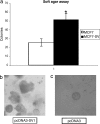Stimulation of proliferation of MCF-7 breast cancer cells by a transfected splice variant of growth hormone-releasing hormone receptor
- PMID: 17372203
- PMCID: PMC1838504
- DOI: 10.1073/pnas.0700407104
Stimulation of proliferation of MCF-7 breast cancer cells by a transfected splice variant of growth hormone-releasing hormone receptor
Abstract
Recent evidence indicates that growth hormone-releasing hormone (GHRH) functions as an autocrine/paracrine growth factor for various human cancers. A splice variant (SV) of the full-length receptor for GHRH (GHRHR) is widely expressed in various primary human cancers and established cancer cell lines and appears to mediate the proliferative effects of GHRH. To investigate in greater detail the role of SV1 in tumorigenesis, we have expressed the full-length GHRHR and its SV1 in MCF-7 human breast cancer cells that do not possess either GHRHR or SV1. In accordance with previous findings, the expression of both GHRHR and SV1 restored the sensitivity to GHRH-induced stimulation of cell proliferation, with SV1 being more potent than the GHRHR. Furthermore, MCF-7 cells transfected with SV1 proliferated more quickly than the controls, even in the absence of exogenously added GHRH, suggesting the existence of intrinsic, ligand-independent activity of SV1 after its transfection. In agreement with the stimulation of cell proliferation, the levels of proliferation markers cyclin D1, cyclin E, and proliferating cell nuclear antigen were elevated in MCF-7 cells treated with GHRH, cultured in both serum-free and serum-containing media. In addition, SV1 caused a considerable stimulation of the ability of MCF-7 cells to grow in semisolid medium, an assay considered diagnostic for cell transformation. Collectively, our findings show that the expression of SV1 confers oncogenic activity and provide further evidence that GHRH operates as a growth factor in breast cancer and probably other cancers as well.
Conflict of interest statement
The authors declare no conflict of interest.
Figures







Similar articles
-
Activation of mitogen-activated protein kinases by a splice variant of GHRH receptor.J Mol Endocrinol. 2010 Feb;44(2):127-34. doi: 10.1677/JME-09-0121. Epub 2009 Nov 6. J Mol Endocrinol. 2010. PMID: 19897610
-
Ligand-dependent and -independent effects of splice variant 1 of growth hormone-releasing hormone receptor.Proc Natl Acad Sci U S A. 2003 Aug 5;100(16):9512-7. doi: 10.1073/pnas.1533185100. Epub 2003 Jul 16. Proc Natl Acad Sci U S A. 2003. PMID: 12867592 Free PMC article.
-
Expression of growth hormone-releasing hormone receptor splice variant 1 in primary human melanomas.Regul Pept. 2008 Apr 10;147(1-3):33-6. doi: 10.1016/j.regpep.2007.12.008. Epub 2008 Jan 11. Regul Pept. 2008. PMID: 18255167
-
Regulation of the pituitary somatotroph cell by GHRH and its receptor.Recent Prog Horm Res. 2000;55:237-66; discussion 266-7. Recent Prog Horm Res. 2000. PMID: 11036940 Review.
-
Antagonists of growth-hormone-releasing hormone: an emerging new therapy for cancer.Nat Clin Pract Endocrinol Metab. 2008 Jan;4(1):33-43. doi: 10.1038/ncpendmet0677. Nat Clin Pract Endocrinol Metab. 2008. PMID: 18084344 Review.
Cited by
-
Activation of Janus kinase/signal transducer and activator of transcription 3 pathway by growth hormone-releasing hormone.Cell Mol Life Sci. 2010 Mar;67(6):959-64. doi: 10.1007/s00018-009-0224-y. Epub 2009 Dec 13. Cell Mol Life Sci. 2010. PMID: 20012909 Free PMC article.
-
Expression of Growth Hormone-Releasing Hormone and Its Receptor Splice Variants in Primary Human Endometrial Carcinomas: Novel Therapeutic Approaches.Molecules. 2022 Apr 21;27(9):2671. doi: 10.3390/molecules27092671. Molecules. 2022. PMID: 35566020 Free PMC article.
-
Antiproliferative effect of growth hormone-releasing hormone (GHRH) antagonist on ovarian cancer cells through the EGFR-Akt pathway.Reprod Biol Endocrinol. 2010 May 28;8:54. doi: 10.1186/1477-7827-8-54. Reprod Biol Endocrinol. 2010. PMID: 20509930 Free PMC article.
-
GHRH antagonists support lung endothelial barrier function.Tissue Barriers. 2019;7(4):1669989. doi: 10.1080/21688370.2019.1669989. Epub 2019 Oct 3. Tissue Barriers. 2019. PMID: 31578921 Free PMC article.
-
Suppression of reactive oxygen species in endothelial cells by an antagonist of growth hormone-releasing hormone.J Biochem Mol Toxicol. 2021 Oct;35(10):e22879. doi: 10.1002/jbt.22879. Epub 2021 Aug 8. J Biochem Mol Toxicol. 2021. PMID: 34369038 Free PMC article.
References
-
- Schally AV, Comaru-Schally AM, Nagy A, Kovacs M, Szepeshazi K, Plonowski A, Varga JL, Halmos G. Front Neuroendocrinol. 2001;22:248–291. - PubMed
-
- Schally AV, Varga JL. Comb Chem High Throughput Screen. 2006;9:163–170. - PubMed
-
- Kiaris H, Schally AV, Kalofoutis A. Vitam Horm. 2005;70:1–24. - PubMed
-
- Kiaris H, Koutsilieris M, Kalofoutis A, Schally AV. Expert Opin Investig Drugs. 2003;12:1385–1394. - PubMed
Publication types
MeSH terms
Substances
LinkOut - more resources
Full Text Sources
Medical
Research Materials

